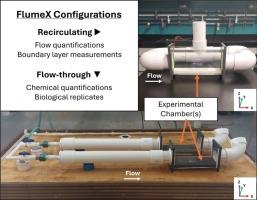FlumeX: A modular flume design for laboratory-based marine fluid-substrate studies
IF 2.1
Q3 ENGINEERING, ELECTRICAL & ELECTRONIC
引用次数: 0
Abstract
As research becomes more interdisciplinary, researchers develop new methodologies and technologies for novel experiments that bridge fields. FlumeX’s design features a standard experimental chamber that can be expanded into different configurations, allowing for cross-disciplinary experiments between the fields of fluid dynamics, chemical oceanography, and biology. An open-ended, flow-through configuration is ideal for simulating environments where water is constantly flushed, capable of simulating oceanic environments. A fully enclosed, recirculating configuration is ideal for particle image velocimetry experiments, standard for fluid dynamics. FlumeX is designed to allow for husbandry of sessile organisms, including corals, in tandem with chemical and physical measurements. FlumeX allows for flexibility in experimental design and comparable environments between recirculating and flow-through configurations. It is designed with low-cost, readily available materials, making it easy to build and produce en masse for replicate testing.

FlumeX:用于实验室海洋流体基质研究的模块化水槽设计
随着研究变得更加跨学科,研究人员开发了新的方法和技术来进行跨领域的新颖实验。FlumeX的设计特点是一个标准的实验室,可以扩展成不同的配置,允许在流体动力学、化学海洋学和生物学领域之间进行跨学科的实验。一个开放式的,流动的配置是理想的模拟环境,水是不断冲洗,能够模拟海洋环境。一个完全封闭的,再循环的配置是理想的粒子图像测速实验,流体动力学的标准。FlumeX的设计允许在化学和物理测量的同时,对包括珊瑚在内的无根生物进行饲养。FlumeX在实验设计和再循环和直通配置之间的可比环境中具有灵活性。它采用低成本,现成的材料设计,使其易于构建和批量生产以进行重复测试。
本文章由计算机程序翻译,如有差异,请以英文原文为准。
求助全文
约1分钟内获得全文
求助全文
来源期刊

HardwareX
Engineering-Industrial and Manufacturing Engineering
CiteScore
4.10
自引率
18.20%
发文量
124
审稿时长
24 weeks
期刊介绍:
HardwareX is an open access journal established to promote free and open source designing, building and customizing of scientific infrastructure (hardware). HardwareX aims to recognize researchers for the time and effort in developing scientific infrastructure while providing end-users with sufficient information to replicate and validate the advances presented. HardwareX is open to input from all scientific, technological and medical disciplines. Scientific infrastructure will be interpreted in the broadest sense. Including hardware modifications to existing infrastructure, sensors and tools that perform measurements and other functions outside of the traditional lab setting (such as wearables, air/water quality sensors, and low cost alternatives to existing tools), and the creation of wholly new tools for either standard or novel laboratory tasks. Authors are encouraged to submit hardware developments that address all aspects of science, not only the final measurement, for example, enhancements in sample preparation and handling, user safety, and quality control. The use of distributed digital manufacturing strategies (e.g. 3-D printing) is encouraged. All designs must be submitted under an open hardware license.
 求助内容:
求助内容: 应助结果提醒方式:
应助结果提醒方式:


